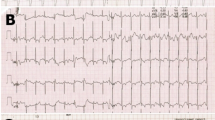Abstract
Ventricular premature beats (VPBs) in a structurally normal heart generally are a benign condition. Rarely, however, reversible cardiomyopathy may develop. This study aimed to evaluate the incidence of cardiomyopathy among pediatric patients in a cohort with frequent VPBs and to examine the characteristics of the ventricular ectopic beats as well as therapeutic options. This study reviewed the charts of all pediatric patients between the ages of 1 day and 18 years seen at the University of Kentucky with the diagnosis of VPBs between 2003 and 2007. Frequent VPBs were defined as an ectopy burden of 5% or more in 24 h. Electrocardiograms, Holter monitors, and echocardiograms were reviewed. The review identified 28 patients (17 boys, age 13.3 ± 5.9 years, and 11 girls, age 13 ± 5.2 years) with frequent VPBs. The echocardiograms of four patients (2 boys, 14%) showed cardiomyopathy. Cardiac function normalized in all four patients, with spontaneous resolution of the VPBs (2 patients) or with antiarrhythmic therapy (2 patients). During a follow-up period of 2.7 ± 2.3 years, 32% of the patients without cardiomyopathy showed a marked spontaneous improvement in arrhythmia burden. Most of the patients showed VPBs with a left bundle branch block (LBBB) and inferior axis morphology. The most commonly associated symptoms were chest pain (17.8%) and dizziness and syncope (21.4%). Generally, VPBs in structurally normal hearts are considered benign. Rarely, a reversible cardiomyopathy can develop, requiring therapeutic intervention.
Similar content being viewed by others
References
Bogun F, Crawford T, Reich S, Koelling TM, Armstrong W, Good E, Jongnarangsin K, Marine JE, Chugh A, Pelosi F, Oral H, Morady F (2007) Radiofrequency ablation of frequent, idiopathic premature ventricular complexes: comparison with a control group without intervention. Heart Rhythm 4:863–867
Chugh SS, Shen WK, Luria DM, Smith HC (2000) First evidence of premature ventricular complex-induced cardiomyopathy: a potentially reversible cause of heart failure. J Cardiovasc Electrophysiol 11:328–329
De Rosa G, Butera G, Chessa M, Pardeo M, Bria S, Buonuomo PS, Zecca E, Romagnoli C (2006) Outcome of newborns with asymptomatic monomorphic ventricular arrhythmia. Arch Dis Child Fetal Neonatal Ed 91:F419–F422
Duffee DF, Shen WK, Smith HC (1998) Suppression of frequent premature ventricular contractions and improvement of left ventricular function in patients with presumed idiopathic dilated cardiomyopathy. Mayo Clin Proc 73:430–433
Herczku C, Kun C, Edes I, Csanadi Z (2007) Radiofrequency catheter ablation of premature ventricular complexes improved left ventricular function in a nonresponder to cardiac resynchronization therapy. Europace 9:285–288
Jacobsen JR, Garson A, Gillette PC, McNamara DG (1978) Premature ventricular contractions in normal children. J Pediatr 92:36–38
Redfearn DP, Hill JD, Keal R, Toff WD, Stafford PJ (2003) Left ventricular dysfunction resulting from frequent unifocal ventricular ectopics with resolution following radiofrequency ablation. Europace 5:247–250
Sekiguchi Y, Aonuma K, Yamauchi Y, Obayashi T, Niwa A, Hachiya H, Takahashi A, Nitta J, Iesaka Y, Isobe M (2005) Chronic hemodynamic effects after radiofrequency catheter ablation of frequent monomorphic ventricular premature beats. J Cardiovasc Electrophysiol 16:1057–1063
Shiraishi H, Ishibashi K, Urao N, Tsukamoto M, Hyogo M, Keira N, Hirasaki S, Shirayama T, Nakagawa M (2002) A case of cardiomyopathy induced by premature ventricular complexes. Circ J 66:1065–1067
Sun Y, Blom NA, Yu Y, Ma P, Wang Y, Han X, Swenne CA, van der Wall EE (2003) The influence of premature ventricular contractions on left ventricular function in asymptomatic children without structural heart disease: an echocardiographic evaluation. Int J Cardiovasc Imaging 19:295–299
Takemoto M, Yoshimura H, Ohba Y, Matsumoto Y, Yamamoto U, Mohri M, Yamamoto H, Origuchi H (2005) Radiofrequency catheter ablation of premature ventricular complexes from right ventricular outflow tract improves left ventricular dilation and clinical status in patients without structural heart disease. J Am Coll Cardiol 45:1259–1265
Niwano S, Wakisaka Y, Niwano H, Fukaya H, Kurokawa S, Kiryu M, Hatakeyama Y, Izumi T (2009) Prognostic significance of frequent premature ventricular contractions originating from the ventricular outflow tract in patients with normal left ventricular function. Heart 95:1230–1237
Aliot EM, Stevenson WG, Almendral-Garrote JM, Bogun F, Calkins CH, Delacretaz E, Della Bella P, Hindricks G, Jaïs P, Josephson ME, Kautzner J, Kay GN, Kuck KH, Lerman BB, Marchlinski F, Reddy V, Schalij MJ, Schilling R, Soejima K, Wilber D; European Heart Rhythm Association (EHRA), Registered Branch of the European Society of Cardiology (ESC), Heart Rhythm Society (HRS), American College of Cardiology (ACC), American Heart Association (AHA) (2009) EHRA/HRS expert consensus on catheter ablation of ventricular arrhythmias: developed in a partnership with the European Heart Rhythm Association (EHRA), a Registered Branch of the European Society of Cardiology (ESC), and the Heart Rhythm Society (HRS), in collaboration with the American College of Cardiology (ACC) and the American Heart Association (AHA). Heart Rhythm 6:886–933
Wilber DJ (2009) Ventricular ectopic beats: not so benign. Heart 95:1209–1210
Author information
Authors and Affiliations
Corresponding author
Rights and permissions
About this article
Cite this article
Kakavand, B., Ballard, H.O. & Disessa, T.G. Frequent Ventricular Premature Beats in Children With a Structurally Normal Heart: A Cause for Reversible Left Ventricular Dysfunction?. Pediatr Cardiol 31, 986–990 (2010). https://doi.org/10.1007/s00246-010-9740-7
Received:
Accepted:
Published:
Issue Date:
DOI: https://doi.org/10.1007/s00246-010-9740-7




